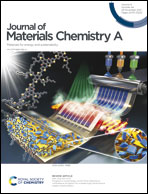Efficient N2 reduction with the VS2 electrocatalyst: identifying the active sites and unraveling the reaction pathway†
Abstract
The electrochemical nitrogen reduction reaction (NRR) is an effective method for sustainable production of NH3. However, a robust NRR electrocatalyst is predominantly required in order to activate the inert N2 molecule. In this article, we report the synthesis of flower-like VS2 (FL-VS2) as a high-performance NRR electrocatalyst. FL-VS2 shows the highest NH3 yield of 34.62 μg h−1 mgcat−1 with a faradaic efficiency (FE) of 2.09%, which is higher than that of the counterparts. By using first-principles calculations, we identify that the S edge site and V edge site of VS2 easily chemisorb H+ and N2, respectively. A typical poisoning experiment verifies that the V site at the edge of FL-VS2 is the active site for the NRR. The conversion of N2 to NH3 is more inclined to follow a hybrid pathway at the VS2 electrocatalyst. This research not only provides an efficient electrocatalyst for the NRR, but also offers theoretical support for identifying the active sites and reaction mechanism of the NRR on transition metal dihalide-based materials.



 Please wait while we load your content...
Please wait while we load your content...